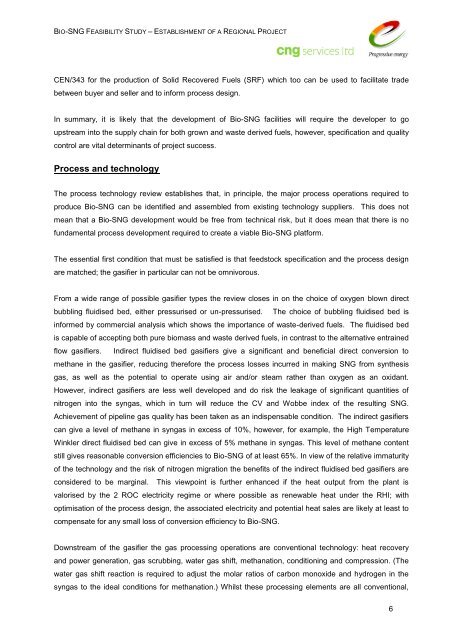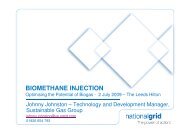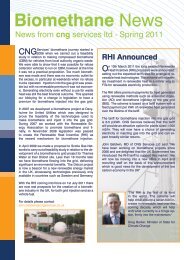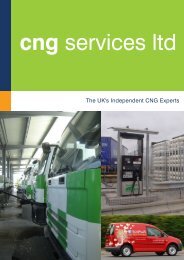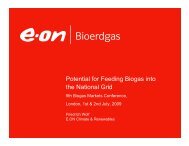Bio-SNG - CNG Services
Bio-SNG - CNG Services
Bio-SNG - CNG Services
You also want an ePaper? Increase the reach of your titles
YUMPU automatically turns print PDFs into web optimized ePapers that Google loves.
BIO-<strong>SNG</strong> FEASIBILITY STUDY – ESTABLISHMENT OF A REGIONAL PROJECTCEN/343 for the production of Solid Recovered Fuels (SRF) which too can be used to facilitate tradebetween buyer and seller and to inform process design.In summary, it is likely that the development of <strong>Bio</strong>-<strong>SNG</strong> facilities will require the developer to goupstream into the supply chain for both grown and waste derived fuels, however, specification and qualitycontrol are vital determinants of project success.Process and technologyThe process technology review establishes that, in principle, the major process operations required toproduce <strong>Bio</strong>-<strong>SNG</strong> can be identified and assembled from existing technology suppliers. This does notmean that a <strong>Bio</strong>-<strong>SNG</strong> development would be free from technical risk, but it does mean that there is nofundamental process development required to create a viable <strong>Bio</strong>-<strong>SNG</strong> platform.The essential first condition that must be satisfied is that feedstock specification and the process designare matched; the gasifier in particular can not be omnivorous.From a wide range of possible gasifier types the review closes in on the choice of oxygen blown directbubbling fluidised bed, either pressurised or un-pressurised. The choice of bubbling fluidised bed isinformed by commercial analysis which shows the importance of waste-derived fuels. The fluidised bedis capable of accepting both pure biomass and waste derived fuels, in contrast to the alternative entrainedflow gasifiers. Indirect fluidised bed gasifiers give a significant and beneficial direct conversion tomethane in the gasifier, reducing therefore the process losses incurred in making <strong>SNG</strong> from synthesisgas, as well as the potential to operate using air and/or steam rather than oxygen as an oxidant.However, indirect gasifiers are less well developed and do risk the leakage of significant quantities ofnitrogen into the syngas, which in turn will reduce the CV and Wobbe index of the resulting <strong>SNG</strong>.Achievement of pipeline gas quality has been taken as an indispensable condition. The indirect gasifierscan give a level of methane in syngas in excess of 10%, however, for example, the High TemperatureWinkler direct fluidised bed can give in excess of 5% methane in syngas. This level of methane contentstill gives reasonable conversion efficiencies to <strong>Bio</strong>-<strong>SNG</strong> of at least 65%. In view of the relative immaturityof the technology and the risk of nitrogen migration the benefits of the indirect fluidised bed gasifiers areconsidered to be marginal. This viewpoint is further enhanced if the heat output from the plant isvalorised by the 2 ROC electricity regime or where possible as renewable heat under the RHI; withoptimisation of the process design, the associated electricity and potential heat sales are likely at least tocompensate for any small loss of conversion efficiency to <strong>Bio</strong>-<strong>SNG</strong>.Downstream of the gasifier the gas processing operations are conventional technology: heat recoveryand power generation, gas scrubbing, water gas shift, methanation, conditioning and compression. (Thewater gas shift reaction is required to adjust the molar ratios of carbon monoxide and hydrogen in thesyngas to the ideal conditions for methanation.) Whilst these processing elements are all conventional,6


